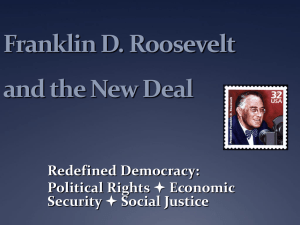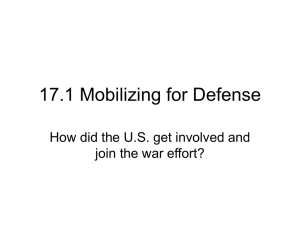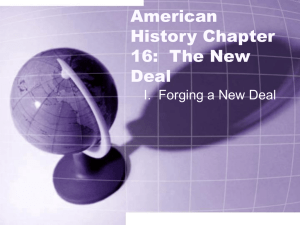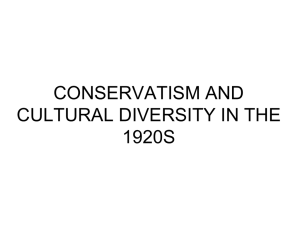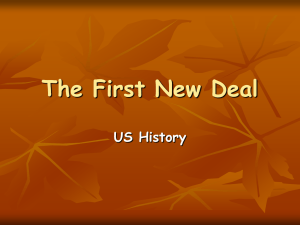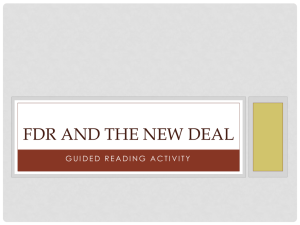Document 5226784
advertisement
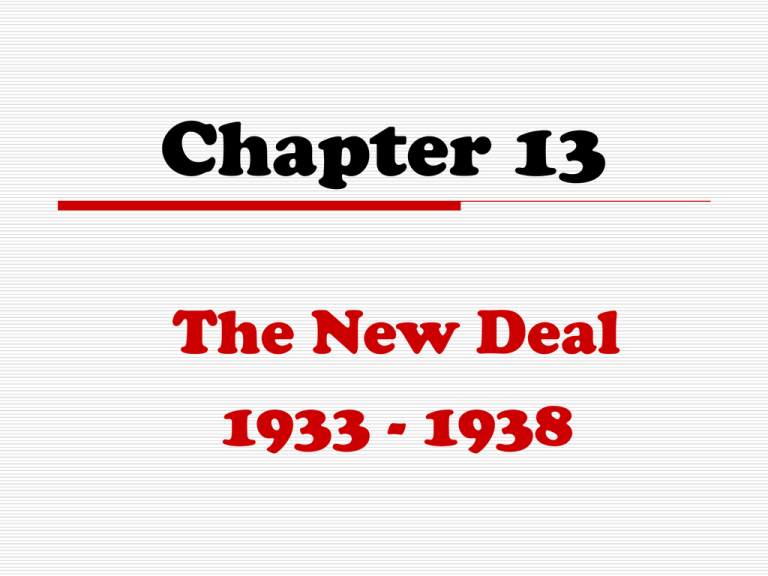
Chapter 13 The New Deal 1933 - 1938 Bell Ringer How would you want government leaders to respond if all the members of your family were out of work, with no hope of finding a job? Forging a New Deal Section 1 Objectives Identify the programs FDR created to restore the nation’s hope and explain the role of Eleanor Roosevelt. Identify key New Deal personnel and explain why the New Deal faltered. Describe the Second New Deal and how the voters responded to it in the 1936 election. Define: New Deal, hundred days, public works program, Tennessee Valley Authority (TVA), Second New Deal, Wagner Act, Social Security System Main Idea President Roosevelt sought to end the Depression through the programs of the New Deal. During FDR’s first “hundred days” in office, he created many “alphabet agencies”—some set up by Congress, others by executive order—to help Americans during this difficult period. *** FDR told the American people at his inauguration: “This nation asks for action and action now!” The New Deal is the name given to programs launched by President Franklin D. Roosevelt during 1933-1937 with the goal of relief, reform and recovery to the national economy. “The only thing we have to fear is fear itself.” Franklin D. Roosevelt Inaugural Address March 4, 1933 The First Hundred Days FDR’s inauguration in March through June 1933 FDR pushed programs through Congress to provide relief, create jobs and stimulate economic recovery Closing the Banks FDR’s first step to restore confidence in the nation’s banks March 5, 1933—ordered all banks to close for 4 days “bank holiday” Congress passed the Emergency Banking Act Authorized the government to inspect the financial health of all banks. 2/3 reopened by March 15th FDIC Federal Deposit Insurance Corporation Insured (protected) bank deposits up to $5000 Providing Relief and Creating Jobs • FERA – Federal Emergency Relief Administration created to send funds to local relief agencies –Harry Hopkins, director “Give a man a (handout) and you save his body and destroy his spirit. Give him a job and pay him an assured wage and you save both the body and the spirit.” Harry Hopkins FERA Director Public Works Programs Government funded projects to build facilities Civil Works Administration (CWA) Gave jobs building or improving roads, parks, airports and other facilities to the unemployed 4 million employees Civilian Conservation Corps (CCC) Gave jobs restoring forests, beaches and parks Over 2.5 million young, unmarried men CCC workers earned $1 per day Workers lived in camps free of charge They received food, medical care and job training What long-term benefits did workers get from working in the CCC? Helped Native Americans •John Collier--FDR’s commissioner of Indian Affairs --Built schools, hospitals and irrigation systems •Indian Reorganization Act of 1934 --Ended the sale of tribal lands (Dawes Act of 1887) and restored ownership of some lands to Indian groups. The Great Depression was the worst economic calamity in American history Several flawed economic and political policies contributed to the stock market crash The Depression affected Americans of all economic and social classes The New Deal demanded significant spending on the federal level to combat the Depression The New Deal sought to solve the problems of the Depression by providing public works projects, as well as by promoting the arts The New Deal changed the role of government in American life The reach and impact of the New Deal affected American life from the 1930s into the 21st century A Helping Hand to Business NIRA – National Industrial Recovery Act wanted to raise prices to help industries NRA (National Recovery Administration) was established to balance the unstable economy New codes to regulate wages, working conditions, production and prices. Set a minimum wage Gave organized labor collective bargaining rights Higher wages = Higher prices Consumers stopped buying Public Works Administration (PWA) Directed by Harold Ickes Was the best part of the NRA because the codes they enacted had failed, but the work of the PWA was successful Grand Coulee Dam on Columbia River (WA) Causeway connecting Key West to FL Tribourough Bridge (NYC) Grand Coulee Dam Causeway connecting Key West to mainland Florida Tribourough Bridge in New York City (1935) Federal Securities Act Required companies to provide information about their finances if they offered stock Securities and Exchange Commission (SEC) Set up to regulate the stock market Saving Homes and Farms • HOLC – Home Owners’ Loan Corporation –Refinanced mortgages to make payments more manageable Saving Homes and Farms • AAA – Agricultural Adjustment Administration –Tried to raise farm prices through government financial assistance (subsidies) Tennessee Valley Authority (TVA) Created in May 1933 Helped farmers and created jobs Provided cheap electric power, flood control and recreational opportunities to the Tennessee River Valley To how many states did the TVA provide service? (p. 407) Eleanor Roosevelt Supported New Deal programs and FDR Traveled for FDR (who was disabled) FDR was her distant cousin; together they had six children Read the biography on p. 407 FDR was the first president with a significant physical disability. FDR was diagnosed with infantile paralysis, better known as polio, in 1921, at the age of 39. Although dealing with this crippling disease was difficult, many believe that his personal struggles helped shape FDR, both as a man and as a president. The New Deal Falters (Fails) Programs failed to bring significant economic improvement People worried about the increased power that New Deal agencies gave the federal government. A Second New Deal The period in 1935 where FDR launched a new burst of legislative activity Second New Deal, cont. More social welfare benefits Stricter controls over business Stronger support for unions Higher taxes on rich WPA (Works Progress Administration) set up in 1935 provided 8 million jobs constructed or improved playgrounds, schools, hospitals and airfields supported work of artists and writers Resettlement Agency (replaced later by Farm Security Administration (FSA) in 1937 • loaned over $1 billion to farmers and set up camps for migrant workers New Labor Legislation • Workers wanted their rights protected – National Labor Relations Act (Wagner Act) – named after leading advocate, Robert Wagner » legalized collective bargaining » outlawed spying on union activities and blacklisting NLRB (National Labor Relations Board) – set up to enforce Wagner Act Fair Labor Standards Act (1938) banned child labor established minimum wage Social Security Act (1935) established a Social Security System provide regular payments to people who could not support themselves old-age pensions and survivor’s benefits unemployment insurance aid for dependent children, blind and physically disabled 1936 Election FDR won in a landslide victory Showed that most Americans supported the New Deal AGENCY CCC WPA PWA NRA NLRB FDIC SEC AAA SSA PURPOSE What was the general mood when FDR was sworn into office on March 4, 1933? 1.How is FDR portrayed? 2.What challenges does FDR face as he embarks on his new job as president? 3.What objects are included in the cartoon and what do they symbolize? 4.What does “man of the hour” mean? The New Deal’s Critics Section 2 What are some of the agencies set up by FDR with the New Deal? Objectives • Identify which Americans received only limited benefits from the New Deal. • Describe how politicians and demagogues criticized the New Deal. • Define: – American Liberty League – Demagogue – Nationalization “I pledge to you, I pledge myself, to a new deal for the American people” Franklin D. Roosevelt Democratic National Convention Main Idea A variety of critics pointed out the shortcomings of the New Deal as well as its potential for restricting individual freedom. Limits of the New Deal Women put at a disadvantage a. NRA codes allowed lower wages for women’s work b. Men and boys received preference in relief and job programs African Americans a. Racial segregation reinforced by relief programs in the South b. Kept out of skilled jobs and received lower pay c. “last hired, first fired” i. Highest unemployment rate of any group during the Great Depression Political Critics I. New Deal Does Too Much a. Many Republicans opposed Roosevelt i. Felt the New Deal went too far b. Wealthy people i. Higher taxes on the rich c. American Liberty League i. Founded in 1934 ii. Led much of the opposition to the New Deal iii. Alfred E. Smith, leader iv. John J. Raskob and DuPont Family v. Argued that the New Deal limited individual freedom and was “un-American” American Liberty League Founded in 1934 and led much of the opposition to the New Deal II. New Deal Does Not Do Enough a. Progressives and Socialists attacked programs for not providing enough help b. 1934 – Upton Sinclair (muckraker) ran for governor of California i. EPIC –END POVERTY IN CALIFORNIA ii. Opponents used shady tactics to discredit him c. New Deal did not eliminate poverty i. Led to a revival in progressivism in Minnesota and Wisconsin 1. Robert La Follette, Jr. (WI) 2. Philip La Follette III. Other Critics a. Demagogues –manipulate people with half-truths, deceptive promises and scare tactics i. Father Charles E. Coughlin 1. used his radio broadcast in Detroit to criticize the New Deal 2. attacks grew beyond FDR and also toward Jews ii. Huey Long 1. worked to help underprivileged, improving education and medical care 2. wanted to “share the wealth” with limits on income and higher taxes Demagogue Leaders who manipulate people with half-truths, deceptive promises and scare tactics Father Charles E. Coughlin “Radio Priest” in Detroit Nationalization Conversion to government ownership Charles E. Coughlin advocated for government ownership of banks and the redistribution of their wealth IV. Court-Packing Scheme a. FDR’s attempt to “pack” the Supreme Court i. Put more judges in place that favored the New Deal Last Days of the New Deal Section 3 Bell Ringer *What are the three “R’s” that FDR’s programs and the New Deal were aimed to do? *Name one demagogue who criticized FDR and the New Deal. Objectives • Explain what caused the recession of 1937. • Identify labor union triumphs resulting from the New Deal. • Describe the effects of the New Deal in terms of culture and lasting achievements. • Define: – National debt – Revenue – Coalition – Sit-down strike national debt The total amount of money the federal government has borrowed and not yet paid back revenue income coalition alliance goals of groups with similar sit-down strike where laborers stop working but refuse to leave the workplace Main Idea The New Deal had a lasting effect on many aspects of American life. The Recession of 1937 I. The New Deal did not end the Depression a. Massive government spending led to economic improvement b. Economy collapsed in 1937 i. Industrial production fell, employment levels dropped II. Social Security tax partly to blame a. Tax came out of worker’s paychecks b. Less money in paychecks; workers bought fewer goods III. Concern about national debt caused a reduction in government spending National Debt Year 1933 1940 2014 Amount $21,000,000,000 $43,000,000,000 $18,000,000,000,000 Running National Debt Clock (click) Unions Triumph The Wagner Act provided federal protection for the activities of labor unions, making unions more attractive to workers. Union membership rose from 3 million to 10.5 million by 1941. I. A New Labor Organization A. Congress of Industrial Organizations 1. formerly CIO 2. sought to organize workers 3. a coalition (alliance of groups with similar interests) 4. John J. Lewis; first president 5. aim was to challenge industry conditions II. An Era of Strikes A. Sit-Down Strikes 1. laborers stopped working but refused to leave the workplace 2. UAW (United Auto Workers) occupied GM’s plants in Flint, MI a. Most famous strike b. GM executives turned off the heat and blocked entry of food, called police c. Violence erupted d. Eventually GM gave in 3. Henry Ford resisted unions a. UAW officials were beaten near Detroit Flint Sit-Down Strike (5m) Strike Riots-1937 (1:30m) Henry Ford 1941 Strike (3m) New Deal’s Effects on Culture I. Literature A. The Good Earth by Pearl S. Buck (1931) B. The Grapes of Wrath by John Steinbeck (1939) C. Their Eyes are Watching God by Zora Neale Hurston (1937) ENTERTAINMENT A. Radio was a major source of entertainment B. Soap operas C. Technicolor movies (1933) D. Drive-in movie theaters (1933) E. The Wizard of Oz (1939) F. Snow White and the Seven Dwarfs (1937) III. The WPA and the Arts A. Federal Writer’s Project 1. established in 1935 2. assisted over 6000 writers B. Federal Music Project 1. started community symphonies and free music lessons C. Federal Art Project 1. 1935; directed by Hallie Flanagan a. Used drama to create awareness of social problems b. Controversial Lasting New Deal Achievements I. Public Works and Federal Agencies A. Many bridges, dams, tunnels, public buildings and hospitals still stand today B. TVA is a model for government planning C. FDIC still guarantees bank deposits D. SEC still monitors stock market E. Farmers still plant according to government guidelines in rural areas I. Social Security A. Still many critics II. A Legacy of Hope A. The New Deal restored a sense of hope Questions 1. In what sense did labor triumph in the 1930s? 2. Look at the chart on p. 417. In which year was the deficit the greatest? The lowest? 3. How did sit-down strikes differ from other strikes? 4. In what ways can art be considered a necessity and not a luxury? 5. How did the Wagner Act affect labor unions in the United States? Why did President Roosevelt and the New Deal spark criticism? Ch. 13 Sect. 1-2 Quiz Name/Date/Hour 1. Name the three “R’s” that FDR’s New Deal programs were aimed to do. 2. What was FDR’s wife’s first name? 3. Name one demagogue who criticized FDR’s New Deal. 1.Who are the three people depicted in this cartoon? 2. How is Roosevelt depicted by the illustrator? 3. Do you think this cartoon is optimistic or pessimistic of the “New Deal” Programs? New Deal Parody • What is a parody? • How is FDR portrayed? • What is the message here about the New Deal? FDR Playing with Alphabet Cards, 1933 Supporters v. Critics What was everyone saying? In each stack provided, you have 16 statements. Sort the statements between supporters and critics of the New Deal What would supporters have said to defend FDR and the New Deal? What did critics (other politicians and demagogues think about the New Deal? Don’t forget your hashtag! *Take on the perspective of either a supporter or critic of the New Deal. *Send a tweet of fact-based information regarding your position. *You may send it to anyone from the time period.

